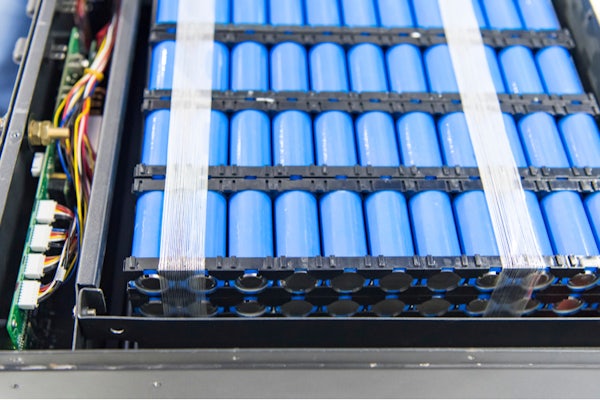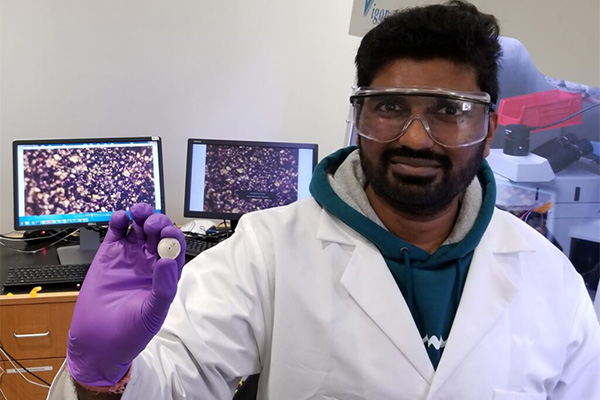Simple tools reveal high-fidelity truth in lithium-ion batteries
Vast majority of active particles in battery holds no share, instead, current is concentrated in ‘hot spots’ dictated by electrochemical phase transformation

Acceleration due to gravity here on Earth is about 9.8m/s^2, but if you’re trying to build a rocket that will escape Earth’s pull, you’re going to have to do better than that. You would need to factor in wind resistance, heat and other factors. In the real world, forces affect each other and sometimes you can’t understand how until you watch a rocket in motion.
New research from the lab of Peng Bai, assistant professor in the Department of Energy, Environmental & Chemical Engineering at the McKelvey School of Engineering at Washington University in St. Louis, echoes this concept.
By watching the charges move through a lithium-ion battery electrode particle by particle, and calculating the true current density at any given spot via image analysis, Bai has been able to determine what needs to be done to build a safer battery, and it has nothing to do with the capability of individual particles.
Instead, particles need to share the burden.
“We need to promote more particles to participate” in the reaction throughout the whole electrode, Bai said. “Then we can lower the actual local current density and avoid generating hazardous hot spots.”
The research was published online Feb. 12, 2021, in the journal Advanced Energy Materials.
Bai and Shubham Agrawal, a doctoral student in Bai’s lab, used graphite as a model system to investigate the movement of charges in lithium-ion battery electrodes. Graphite is a standard anode material for commercial lithium-ion batteries. During battery recharge, lithium ions can diffuse into the vacancies in the graphite crystal structure and induce what is called a solid-state phase transformation. As a result, the induced new phases of graphite, i.e. lithiated graphite, change color from dark gray, to blue, to red and eventually to gold, as more and more lithium ions are accommodated.

used for optical observation at its center. (Photo: Rajeev Gopal)
This special optical property allowed Bai and Agrawal to directly determine lithium ions’ distribution in the electrode. Using further image analysis, they could determine the movement of the charges. “When we started charging the electrode, we saw only a few regions changed color,” Agrawal said, “but very large regions were still gray.”
After analyzing thousands of images of the electrode during the recharging process, they were able to determine the true current density (a measure of the accumulated charge per unit time on a certain area) in the areas that had changed color. The current density in the gray areas was zero.
“Similar phenomenon was reported before,” Bai said, “but only if the dynamics can be explained by a mathematical model can we claim it as the high-fidelity truth.” In this work, Bai developed a new mathematical model that can precisely correlate the observed movement of charges with the measured current density. “The local current density is at least two orders of magnitude higher than the apparent current density,” Bai said, referring to places with higher current densities as “hot spots.”
The apparent current density is the average of the total current over the entire area of the electrode, including the inactive gray areas, which is the quantity currently used in battery design. “But it becomes obvious now that it is the local current density that really matters,” Bai said. Local hot spots affect the function of a battery doing anything from decreasing its efficiency to causing a battery malfunction, making them potentially dangerous.
“Synchrotron X-ray-based methods are usually used for this type of characterization,” said Agrawal, “but we demonstrated here that an economical benchtop optical microscope can provide very useful and complementary information.” This method has helped Agrawal to obtain tens of thousands of images for each of his coin cells. The results ensure a comprehensive validation of the mathematical model and the physical insights it can generate.
Experimental batteries are usually specially designed and the structure and working conditions could be very different from the commercial batteries. “This is why we must use a mathematical model to factor in all the differences and translate the understandings into the guidance suitable practical applications,” Bai said.
“When you really check local current density, you realize that it is controlled by the phase transformation, at two levels,” Bai said. It determines how many particles participate in the reaction and how fast one color will sweep across an individual particle. The important part, Bai added, is that now they understand what is actually happening inside a battery and what process is driving it. “You cannot use the very-well established, classical theories of electrochemistry for ideal flat electrodes to understand an electrochemical engineering problem in thick porous electrodes.”




